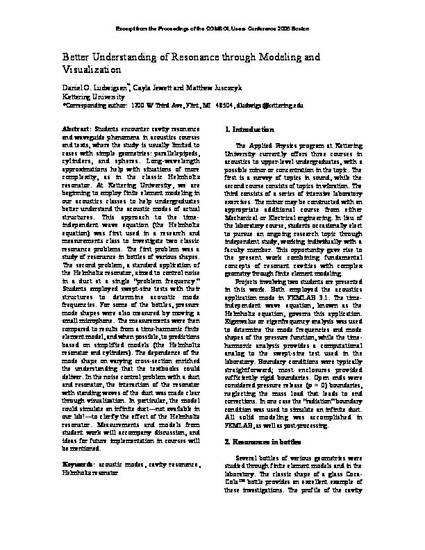
Students encounter cavity resonance and waveguide phenomena in acoustics courses and texts, where the study is usually limited to cases with simple geometries: parallelepipeds, cylinders, and spheres. Long-wavelength approximations help with situations of more complexity, as in the classic Helmholtz resonator. At Kettering University, we are beginning to employ finite element modeling in our acoustics classes to help undergraduates better understand the acoustic modes of actual structures. This approach to the time-independent wave equation (the Helmholtz equation) was first used in a research and measurements class to investigate two classic resonance problems. The first problem was a study of resonance in bottles of various shapes. The second problem, a standard application of the Helmholtz resonator, aimed to control noise in a duct at a single “problem frequency.” Students employed swept-sine tests with their structures to determine acoustic mode frequencies. For some of the bottles, pressure mode shapes were also measured by moving a small microphone. The measurements were then compared to results from a time-harmonic finite element model, and when possible, to predictions based on simplified models (the Helmholtz resonator and cylinders). The dependence of the mode shape on varying cross-section enriched the understanding that the textbooks could deliver. In the noise control problem with a duct and resonator, the interaction of the resonator with standing waves of the duct was made clear through visualization. In particular, the model could simulate an infinite duct—not available in our lab!—to clarify the effect of the Helmholtz resonator. Measurements and models from student work will accompany discussion, and ideas for future implementation in courses will be mentioned.
Available at: http://works.bepress.com/daniel-ludwigsen/4/

Rights Statement: "The author has the copyright. You don't need permission from COMSOL. As long as the authors are OK with publishing it, you are fine." via Mao Mao, Ph.D., COMSOL March 10, 2017
© 2006 Ludwigsen, Jewett, Jusczcyk